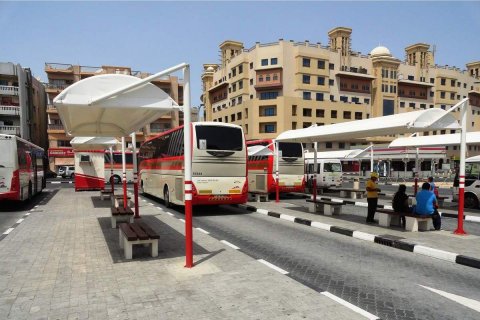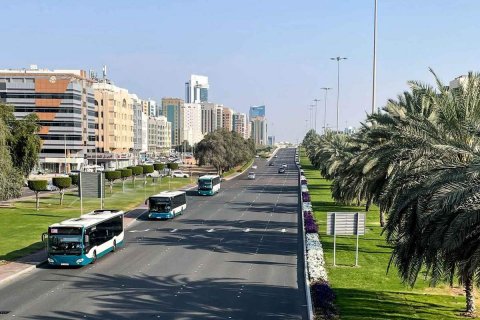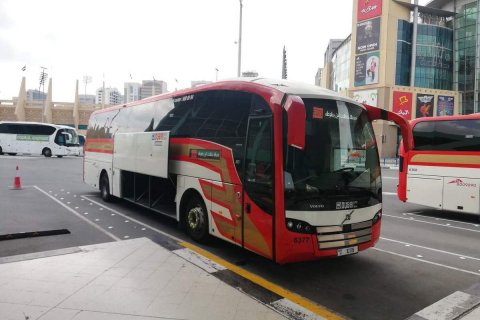
Dubai and Abu Dhabi are separated by around 140 km, and every day thousands of residents and tourists travel between these two emirates. The average journey time is between 1.5 and 2 hours, depending on the chosen mode of transport and traffic conditions. The main means of transportation are intercity buses, taxis, rental cars, and transfers provided by airlines for their passengers.
Buses run every 20–60 minutes; the fare is 25 AED ($7), paid with a Nol Card. Taxis are more expensive, at 220–300 AED ($60–82) or more, but allow you to travel quickly and comfortably right to your desired address. Car rental starts from 130 AED ($35) per day, with additional costs for fuel and parking, but the trip becomes as flexible as possible. For airline passengers, dedicated buses are available for transfers between airports, sometimes at no extra charge.
In the coming years, a high-speed railway between Dubai and Abu Dhabi is planned, supervised by Etihad Rail. This project will reduce travel time to 30 minutes, significantly improving the quality of life for citizens and residents, as well as strengthening socio-economic ties between the two emirates.
Contents:
Bus
Buses are one of the most convenient and affordable ways to travel between the emirates. This option is chosen by both tourists and locals, as it combines comfort and a low fare. Modern buses are equipped with air conditioning, comfortable seats, dedicated spaces for women and children, luggage compartments, and free Wi-Fi. The average travel time is about 2 hours, although during peak hours the journey may take a bit longer.
You can pay your fare using a Nol Card – this card is valid for all types of public transport in Dubai. Buses run daily from early morning until late evening, and intervals generally do not exceed half an hour. This flexibility means passengers aren’t tied to a rigid schedule and can plan their trip at any convenient time. The most popular routes are E100, E101, and E102.
There is also a route from Dubai International Airport that involves several transfers. Passengers can take bus C01 to the Gold Souq market, then transfer to bus X13 to Al Ghubaiba, and finally transfer to E100. E100 buses operate from the Al Ghubaiba bus station in Bur Dubai to Abu Dhabi’s central bus station:
- Travel time: about 2 hours.
- Fare: 25 AED ($7).
- Intervals: every 20–30 minutes.
- Best for passengers living or working near Deira or the Old City.
The E101 route runs from Ibn Battuta bus station to Abu Dhabi’s central bus station:
- Travel time: about 85–100 minutes.
- Fare: 25 AED ($7).
- Intervals: every 30–35 minutes.
- Best for residents of Jebel Ali, Dubai Marina, and Jumeirah Lake Towers.
E102 buses run from Ibn Battuta to Mussafah Shabiya bus station in Abu Dhabi:
- Travel time: about 100 minutes.
- Fare: 25 AED ($7).
- Intervals: every 30–60 minutes.
- Best for passengers heading to Abu Dhabi International Airport.
Taxi
Taxi is considered the fastest and most comfortable way to get from Dubai to Abu Dhabi. You can find a taxi almost anywhere in the city: at hotels, shopping malls, or at designated taxi stands. There are also special taxi apps. The trip takes an average of 1.5–2 hours depending on traffic and the chosen route. For travelers with lots of luggage, families with children, or those who prefer private service, this is a convenient alternative to the bus. The fare is metered and usually ranges from 220–300 AED ($60–82).
Note that the price may increase at night or when booking a business-class vehicle. Both cash and bank cards are accepted, and drivers usually speak good English. An additional advantage is the ability to go directly to your desired address without intermediate stops, which is especially important when time is limited. Despite the higher cost compared to public transport, taxis remain a popular choice thanks to speed, comfort, and personalized service.
The most popular online taxi apps are Uber and Careem. Users can book a ride in just seconds and select any type of vehicle, from standard sedans to spacious SUVs. Approximate Uber prices:
- Uber Family: 474–490 AED ($129–133).
- Uber Green: 507 AED ($138).
- Uber Comfort: 507 AED ($138).
- Uber XL: 539–554 AED ($147–151).
- Uber Black: 733 AED ($200).
Recently, Careem also added the option of intercity trips, allowing users to travel from one emirate to another. Average prices also depend on the service class:
- Economy: 352 AED ($96).
- Business: 370 AED ($101).
- Max: 404 AED ($110).
- Careem Kids: 348 AED ($95).
- 5-hour personal driver: 580 AED ($158).
- 10-hour personal driver: 805 AED ($219).
Rental Car
Renting a car is a great option for those who value freedom of movement and want to plan their own route. The drive takes about 1.5–2 hours, and having your own vehicle lets you not only reach the UAE capital, but also visit attractions along the way, such as Saadiyat Beach or theme parks on Yas Island.
Dubai has many international and local rental companies, and you can book a car in advance online or directly at the airport. You’ll need your passport, driver’s license, and a bank card to rent. In most cases, your national license is sufficient, but sometimes an international license is required. Avis is a popular choice. This international company offers a wide range of vehicles and 24/7 roadside assistance in both Dubai and Abu Dhabi.
Rental costs depend on the car class and usually start from 130 AED ($35) per day. Additional payment is required for fuel and, if needed, paid parking in Abu Dhabi. Most cars are equipped with navigation systems, and the roads between the emirates are in excellent condition and well signposted. This option is suitable for families, travelers with active plans, or anyone who prefers comfort and independence from public transport timetables.
Airport Transfer
For airline passengers, a convenient way to get from Dubai to Abu Dhabi is by transfer provided by airlines. This is especially relevant for those with a layover or those planning to continue traveling internationally via Abu Dhabi. For example, Etihad Airways offers a bus service between airports, fully coordinated with flight arrival and departure times. Buses are equipped with air conditioning, comfortable seats, and spacious luggage compartments, ensuring a safe and comfortable ride.
A transfer means you won’t have to search for a taxi, rent a car, or plan your trip independently. For tourists and business travelers, this is an optimal option: you can reach your destination without transfers or waiting, with minimal time and maximum convenience. The transfer is usually included in the ticket price, but sometimes a fee may be charged if booking through the airline’s website or a third-party service. Sample prices from Get Transfer:
- Standard sedan for 3 passengers: 253 AED ($69).
- Premium class: 367 AED ($100).
- SUV for 5 passengers: 301 AED ($82).
- Minivan for 8 passengers: 396 AED ($108).
- Small shuttle for 16 passengers: 771 AED ($210).
- Bus for 50 passengers: 1531 AED ($417).
High-Speed Railway
Etihad Rail is supervising the construction of a high-speed railway that will provide uninterrupted service between Abu Dhabi and Dubai, significantly reducing journey times. The aim of the project is to improve the quality of life for citizens, residents, and guests, as well as strengthen the socio-economic ties between the two emirates. Passenger services are expected to begin in 2026.
High-speed trains with comfortable seats, work and rest areas, and luggage compartments will allow you to travel from Abu Dhabi to Dubai in just 30 minutes, reaching speeds of up to 350 km/h. The route will pass through strategically important areas and tourist spots. The project includes the construction of modern stations offering cafés, shops, service zones, and other amenities.
Comparison of Options
| Method | Travel Time | Cost | Comfort | Best For |
|---|---|---|---|---|
| Bus About | About 2 hours | 25 AED ($7) | Medium: air conditioning, Wi-Fi, luggage compartment | Travelers on a budget, tourists with flexible schedules |
| Taxi | 1.5–2 hours | From 220–300 AED ($60–82) | High: private ride, door-to-door service | Families with children, business travelers, tourists with lots of luggage |
| Rental Car | 1.5–2 hours | From 130 AED ($35) | High: flexible route, maximum comfort | Tourists planning active trips or traveling with a group |
| Airport Transfer | 1.5–2 hours | From 253 AED ($69), if not included in the airfare | High: air conditioning, luggage compartment, schedule adjusts to flights | International travelers |
| High-Speed Railway (from 2026) | 30 minutes | Not set | Medium-high: air conditioning, Wi-Fi, accurate schedule, speed | Tourists, families, business travelers who value their time |
Main Recommendations
- Plan your time considering road congestion. Traffic jams are common on the route between Dubai and Abu Dhabi, especially during morning and evening rush hours as residents commute to and from work. If your trip involves a business meeting or a flight, allow for extra time – at least half an hour. This will help you avoid unnecessary stress and being late.
- Choose the optimal payment method. Bus fares can only be paid using the Nol Card, so it’s best to buy your card in advance and top it up at the metro or bus station. In taxis and rental cars, bank cards are convenient, but it’s also wise to carry some dirhams in cash as sometimes there are issues with card terminals.
- Pay attention to luggage. Buses have luggage compartments, but space in the cabin is limited. It’s much easier to transport large suitcases or sports equipment by taxi or rental car, so choose your transport based on your baggage volume.
- Consider the time of day. Overnight trips are usually faster as the roads are less busy. However, it’s harder to find a bus at this time, so taxi, transfer, or rental car may be a better choice. This is especially relevant for passengers on late-night flights.
- Follow traffic rules. If you rent a car, remember that the UAE has strict laws: speeding, using your phone at the wheel, and abrupt maneuvers are monitored by cameras, and fines can be very high. It’s worth familiarizing yourself with local traffic regulations to avoid unpleasant situations and unnecessary costs.






































